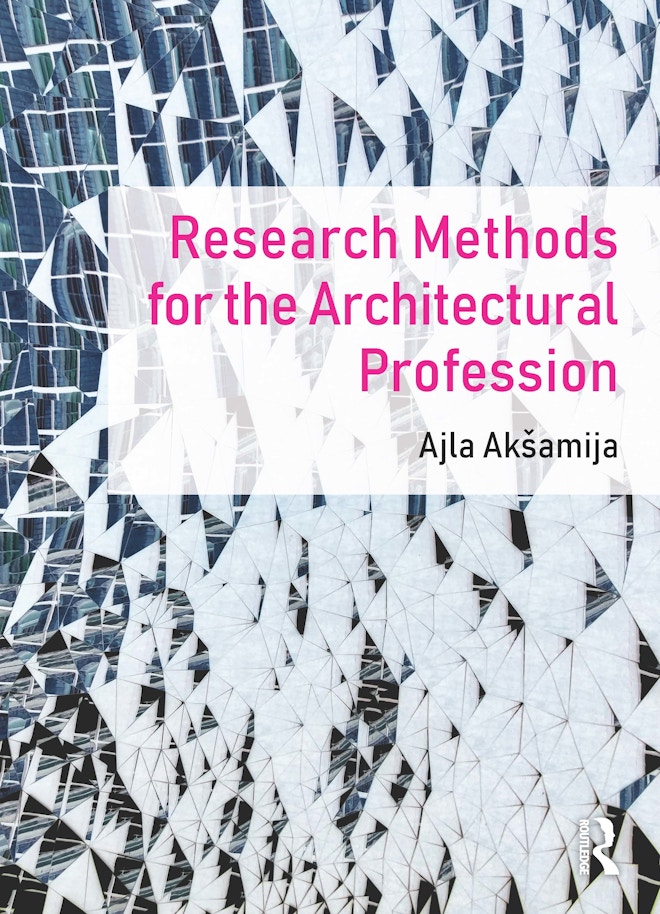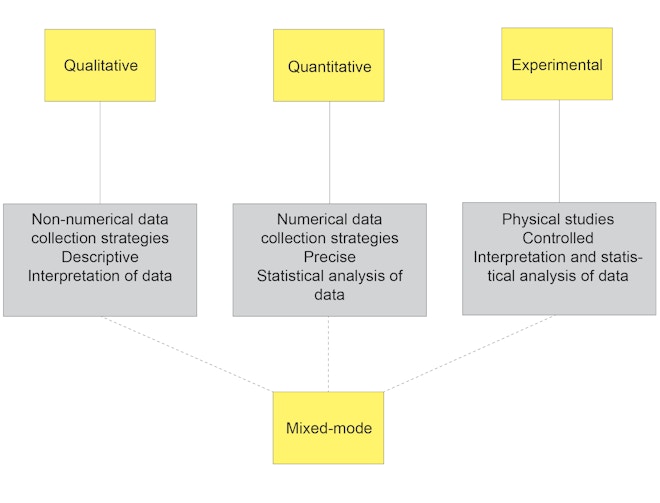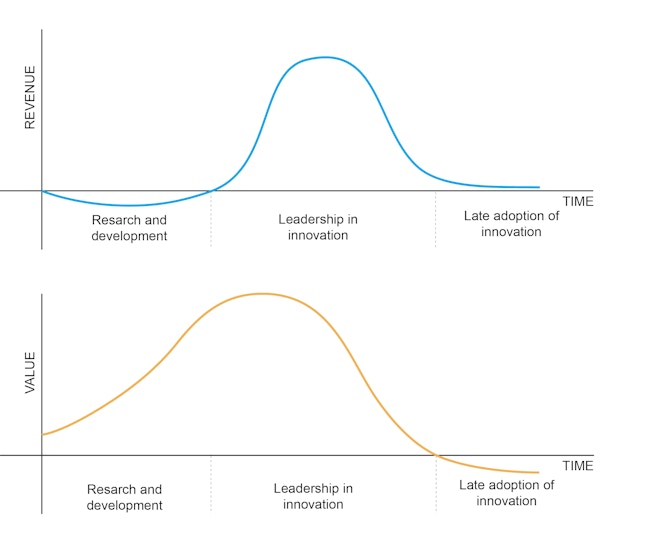Book Review of Research Methods for the Architectural Profession

Book cover
I’ve long noted the lack of convergence on precise definitions for key terms in the building industry, e.g., sustainability, resilience, high-performance and so on. Add research to the list. Faircloth (Friedman et al. 2016) eschews the term altogether, preferring the contextually less ambiguous phrase “searching and searching again.” The lack of a shared understanding of these terms hinders effective communication and the evolution of critical thinking on and practices for vitally important issues challenging the industry. The concept of research has been hashed and rehashed by the architectural profession for decades, but this dialogue has failed to provide a systemic platform for its implementation.
Akšamija cuts through the confusion and controversy like a sharp blade through soft fruit. Research is a focused “systematic investigation” with the intent to “discover or interpret facts and theories, address specific questions, and determine answers to these questions.” (3)
Why a book on architectural research? Well, let’s think about that. Carbon emissions—already at dangerous levels and approaching critical thresholds—continue to rise (with only an apparently brief pandemic interruption) (EIA 2021), and the complicit role of buildings is well known and often discussed. Yet, despite this awareness over many years now, little has changed in the practice of building design and delivery in response. Goals for carbon neutrality in buildings and urban habitat are in place, but progress toward these goals lags. It’s not just carbon emissions threatening humanity; environmental degradation, disappearing resources, urbanization, and social and economic disruptions are combining as existential threats to humanity. In the building sector, massive innovation throughout the building process is required to transition the built environment from its current state to a truly resilient and sustainable future.
In a book released last month on the subject of architectural research, author Ajla Akšamija claims research as an integral component of innovation (18). Investment in R&D in the construction industry has historically lagged other industries (Dickinson 2009), but that may be changing (Ribeirinho et al. 2020, 13). Yet the trend has resulted in a dearth of significant innovation in the building industry over the years. Take the metal and glass curtainwall industry, for example. Little has changed in this technology since its advent in the mid twentieth century. The industry is currently struggling even with incremental developments, like the need for thermally broken framing systems. Whether it’s a lack of investment or a lingering unfamiliarity with research processes and their critical importance, the pace of innovation in the building sector is not nearly matching the need.
The core of the book steps through research processes and methods, with a chapter devoted to each. This is where the fundamental mechanics of research are explicitly and comprehensively articulated. Process steps range from literature review and crafting the right research questions through data collection and analysis to conclusions and dissemination of findings. Research methods include the spectrum of qualitative (archival, interviews, focus groups, observations, qualitative surveys and case studies), quantitative (simulations and modeling, quantitative surveys, correlational), experimental (prototyping, testing, experimental studies) and mixed mode strategies, with detailed procedures for each. The various advantages and disadvantages of each method are discussed in terms of their relevance to various research areas. Case study research is a method discussed in the book, and the author includes a chapter of detailed case studies that serve to further illustrate various research processes and methods. Briefer but informative case studies are scattered throughout the book.

Figure 1: Research process.

Figure 2: Research methods and their characteristics.
Akšamija draws an important distinction between research conducted in the academy and the profession, and explores both realms. The limited research conducted in architectural practice is generally confined in context to an individual and specific building project. The broader non-project related research typical of academia has rarely occurred on the practice side, but Akšamija notes that is starting to change. An entire chapter is dedicated to research in architectural practice. The author is well positioned to articulate research processes in both contexts, as she has long had a foot in each realm, leading the Building Technology Laboratory at Perkins&Will from 2008 to 2013 and is currently on the faculty at the Department of Architecture at the University of Massachusetts Amherst. With building stock set to double by 2050 (IEA 2019), there is exciting potential in the notion of research programs developing within architectural firms; the contribution of new knowledge and innovations could have a profound impact in accelerating the evolution of building technology and practice. Such a development could also drive demand on the academy for better research skills in graduating architecture students, especially from advanced degree programs.

Figure 3: Value of research and impacts on innovation.
Akšamija’s book may well help with both. The author acknowledges that integrating research into architectural practice is challenging, but makes a strong case for the necessity as a means to fuel the innovation needed from the building sector. She also suggests that a research capability may be vital for a firm’s ability to survive as change accelerates through the building sector. She goes a step further, “The future of the architectural profession relies on research.” (30)
The profession needs all the help it can get. Deeply schooled in the value of the unique, of original expression as a means of differentiation, branding and success, the profession resists the rules and structures of appropriate research methodologies. Green (2019, 130) notes our industry’s aversion to quantitative assessment, particularly with respect to post-occupancy evaluation, recognizing a reluctance of the profession to critically examine its work and to admit failure, an aversion that acts as a barrier to effective research practices. “One of the basic tenets of research is that failure, and what that failure tells us, is as important as success.”
Innovators know this gospel truth, but the cost of failure in the construction industry is a powerful barrier to innovation in itself. Akšamija includes a very brief discussion of the “elephant in the room,” risk and its association with uncertainty, innovation and research. She points to the importance of risk management. Much more to talk about here, perhaps a topic in itself, but I question the future progress of research and innovation in the building industry without the consideration of risk fully integrated with research process and methods. Nonetheless, I recognize these barriers to research and innovation as far more of a threat than embracing robust research and innovation initiatives.
Some reading this book will discover that they are doing, or have done, architectural research in one form or another. They will also discover how they could be, or could have been, doing it better. Many advanced degree programs in architecture are, at best, rather haphazard in their research training and education. This may even contribute to the profession lagging other industries in research investment.
I did a late career PhD and wish I’d had this book at the beginning of that journey. Akšamija provides a rich guide through multiple variations of the process, one that will be of interest to many, including:
the young academic will find it valuable in establishing a roadmap for navigating an advanced degree program in architecture or building science,
architecture faculty will find it useful in providing a contextual backdrop for new students pursuing an advanced degree,
firm leaders recognizing the growing importance of an integrated research component to their practice will find it indispensable in implementing such an endeavor,
the young practitioner eager to explore new knowledge beyond the confines of a specific building project,
and anyone in the building industry with a curious mind, a passion, and an interest in sharing; after all, it’s about lifelong learning, right?
The book is well organized, the writing is clear and rational, the content of critical importance to the profession of architecture and the building industry. The citations are extensive, with references at the conclusion of each chapter. The narrative is amply supported with graphic charts, diagrams and tables. In summary, Research Methods for the Architectural Profession is a highly recommended addition to any serious architecture library.

Mic Patterson, PhD, LEED AP+
Ambassador of Innovation & Collaboration
Facade Tectonics Institute
References
Dickinson, Elizabeth Evitts. 2009. Shaky Foundation: Why the U.S. Lags Behind in Building Science Research. Architect. Access: https://www.architectmagazine....
EIA. 2021. Today in Energy: After 2020 decline, EIA expects…U.S. Energy Information Administration. Access: https://www.eia.gov/todayinenergy/detail.php?id=46537#
Friedman, Daniel S., Phillip G. Bernstein, Carol Burns, Joseph G. Burns, Renee Cheng, Carrie Sturts Dossick, Billie Faircloth, Keil Moe, and Michael J. Monti. 2016. Goat rodeo: practicing built environments. Fried Fish Publishing.
Green, David. 2019. Less Grey, More Black and White: Architecture Needs a Consistent Platform in Research. Architectural Design 89, no. 3: 126-133.
IEA. 2019. 2019 Global Status Report for Buildings and Construction. International Energy Agency. Access: https://www.worldgbc.org/news-media/2019-global-status-report-buildings-and-construction
Ribeirinho, Maria João, Jan Mischke, Gernot Strube, Erik Sjödin, Jose Luis Blanco, Rob Palter, Jonas Biörck, David Rockhill, and Timmy Andersson. 2020. The next normal in construction: How disruption is reshaping the world’s largest ecosystem. McKinsey & Company.
Looking for something specific?
Search our extensive library.
FTI’s SKINS email is the central source for the latest in building skin trends and research.
All emails include an unsubscribe link. You may opt out at any time. See our privacy policy.









